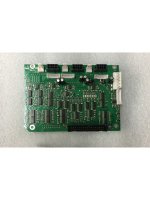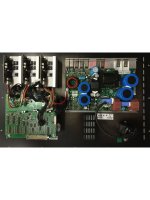What are the part numbers of all the ICs? If they turn out to be opamps then it probably is line level crossover/filtering.
Don't know what kind of IC they are, found the picture on the net, it's from Adam speaker. On the back of that board is a xlr analog input.
a few too many parts to be a simple crossover. If those are all op-amps, it's got a lot of EQ going on.
Best,
Erik
Best,
Erik
a few too many parts to be a simple crossover. If those are all op-amps, it's got a lot of EQ going on.
What is so strange about 4-way active studio monitor (cascaded filters)... Of course it has controls and EQs...
Last edited:
What is so strange about 4-way active studio monitor (cascaded filters)... Of course it has controls and EQs...
I meant, it's strange for a simple crossover. Nothing wrong with doing EQ in an active stage, but it seems like there's a lot of it going on. 😀
Best,
Erik
Yes, it looks like an analog active crossover.
But I wonder whether those caps can be high-quality foil types at all.
Regards
Charles
But I wonder whether those caps can be high-quality foil types at all.
Regards
Charles
My guess is yes, crossover, EQ and other signal processing. Typical of a powered speaker.
wow, that's what I want, do you know where can I get this kind of all in one oxver-eq-processing board? (althou eq is not necessary). I wanna diy a pair of powered speakers.
Yes, it looks like an analog active crossover.
But I wonder whether those caps can be high-quality foil types at all.
Regards
Charles
Analog active crossover, you mean Linkwitz-Riley stuff? The Linkwitz stuff only has 4-order crossover as far as I guess.
Linkwitz Riley is just one of many types of active crossover. Although the 4th order is by far the one that is used most frequently, there is theoretically no restriction when it comes to filter order apart form the fact that they can only be done in even number orders. But you may run into problems of component accuracy when it comes to analog implementations of high orders.
But the crossover type has nothing to do with my remark regading the quality of the capacitors used. Usually, SMD caps can't be had as high quality foil caps.
Regarding a pre-made crossover board: You can't just use a given board like that and use your favourite set of drivers, because the properties of the drivers have to be considered as well for the crossover design.
I can't remember who, but some British member of this forum once made a PCB layout for an active crossover that includes some EQ sections as well to make it more flexible.
Regards
Charles
But the crossover type has nothing to do with my remark regading the quality of the capacitors used. Usually, SMD caps can't be had as high quality foil caps.
Regarding a pre-made crossover board: You can't just use a given board like that and use your favourite set of drivers, because the properties of the drivers have to be considered as well for the crossover design.
I can't remember who, but some British member of this forum once made a PCB layout for an active crossover that includes some EQ sections as well to make it more flexible.
Regards
Charles
Are you sure? I built this 30 years ago (I still have it, updated), and he says you can make it 3rd order. Although I have never done so.Linkwitz Riley is just one of many types of active crossover. Although the 4th order is by far the one that is used most frequently, there is theoretically no restriction when it comes to filter order apart form the fact that they can only be done in even number orders. But you may run into problems of component accuracy when it comes to analog implementations of high orders.
But the crossover type has nothing to do with my remark regading the quality of the capacitors used. Usually, SMD caps can't be had as high quality foil caps.
Regarding a pre-made crossover board: You can't just use a given board like that and use your favourite set of drivers, because the properties of the drivers have to be considered as well for the crossover design.
I can't remember who, but some British member of this forum once made a PCB layout for an active crossover that includes some EQ sections as well to make it more flexible.
Regards
Charles
http://www.saturn-sound.com/images ...e crossover - hi-fi news - march 1981 - 5.jpg
A Linkwitz-Riley crossover is a special case of an in-phase crossover. These are derived by subtracting the output of either a highpass or a lowpass of order 2*N from the output of an allpass of the order N. In the case, where the allpass has Butterworth characteristic and the other branch is consisting of two equal Butterworth secions with the same pole frequency(ies) as the allpass we arrive at a Linkwitz-Riley crossover.
Since there is no allpass of order 1.5 there is no real LR3. But maybe there are approximations around.
I don't know what 3rd order characteristic Ben Duncan intended to use for this project. I guess most probably Butterworth.
There are other 3rd order crossovers possible than just Butterworth. Some of them have interesting properties like low group-delay distortion but their use does often only make sense for very special topologies (like direct radiator woofer combined with horn tweeter).
Regards
Charles
Since there is no allpass of order 1.5 there is no real LR3. But maybe there are approximations around.
I don't know what 3rd order characteristic Ben Duncan intended to use for this project. I guess most probably Butterworth.
There are other 3rd order crossovers possible than just Butterworth. Some of them have interesting properties like low group-delay distortion but their use does often only make sense for very special topologies (like direct radiator woofer combined with horn tweeter).
Regards
Charles
Usually, SMD caps can't be had as high quality foil caps.
Hello, you've mentioned several times about caps, did you mean the crappy caps on the Icepower amp on the right side of the second picture? Didn't see any caps in the first pic which is the crossover board itself... (oh sorry, that xos board indeed has some little caps, they look no good, somebody has to replace them with some decent ones.)
Last edited:
- Status
- Not open for further replies.
- Home
- Loudspeakers
- Multi-Way
- Is this a crossover board?

